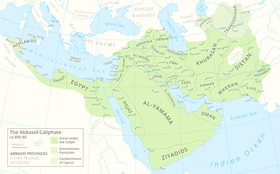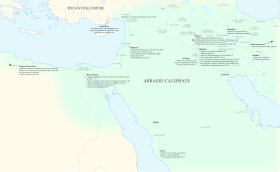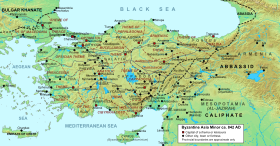al-Wathiq
Abū Jaʿfar Hārūn ibn Muḥammad al-Wathiq bi'Llah (Arabic: أبو جعفر هارون بن محمد, romanized: Abū Jaʿfar Hārūn ibn Muḥammad; 18 April 812 – 10 August 847), commonly known by his regnal name al-Wathiq bi'Llah (Arabic: الواثق بالله, romanized: al-Wāthiq biʾllāh, lit.
The chief events of the reign were the suppression of revolts: Bedouin rebellions occurred in Syria in 842, the Hejaz in 845, and the Yamama in 846, Armenia had to be pacified over several years, and above all, an abortive uprising took place in Baghdad itself in 846, under Ahmad ibn Nasr al-Khuza'i.
In foreign affairs, the perennial conflict with the Byzantine Empire continued, and the Abbasids even scored a significant victory at Mauropotamos, but after a prisoner exchange in 845, warfare ceased for several years.
Al-Wathiq's son al-Muhtadi was passed over due to his youth, and his half-brother al-Mutawakkil (r. 847–861) was chosen as the next caliph by a coterie of leading officials.
[4] The early life of al-Wathiq is obscure, all the more since his father was initially a junior prince without prospects of succession,[1] who owed his rise to prominence, and eventually to the caliphate, to his control of an elite private army of Turkic slave troops (ghilman).
[1][6] He is then mentioned in the account of al-Tabari as being sent to ceremonially welcome the general al-Afshin during his victorious return from the suppression of the revolt of Babak Khorramdin in 838 (in present-day Iran),[1] and being left behind as his father's deputy during the Amorion campaign of the same year.
[1] As historian John Turner remarks, these reports show al-Wathiq in the "role of a trusted agent of his father, which positioned him well to take over the reins of power".
[8][9] Inheriting a full treasury, the new caliph made generous donations to the common people, especially in Baghdad and the Islamic holy cities of Mecca and Medina.
[10] Al-Wathiq's reign was short and is generally considered to have been essentially a continuation of al-Mu'tasim's own, as the government continued to be led by men that had been raised to power by al-Mu'tasim: the Turkic military commanders Itakh, Wasif, and Ashinas, the vizier, Muhammad ibn al-Zayyat, and the chief qadi (judge), Ahmad ibn Abi Duwad.
[8][11][12] These men had been personally loyal to al-Mu'tasim, but were not similarly bound to al-Wathiq; in practice, according to Turner, this narrow circle "controlled the levers of power and thus the Caliph's independence".
[18] However, in 843/44, the Caliph—allegedly at the instigation of the vizier Ibn al-Zayyat, or, according to a story reported by al-Tabari, inspired by the downfall of the Barmakids under Harun al-Rashid—arrested, tortured, and imposed heavy fines on several of the secretaries in the central government, in an effort to raise money to pay the Turkic troops.
[19] The measure was at the same time possibly aimed at driving a wedge between civilian and military elites,[20] or at reducing the power of the leading Turkic commanders, such as Itakh and Ashinas, since most of the secretaries arrested and forced to pay were in their service.
[22] Taking advantage of the dissensions among the tribesmen, al-Hidari quickly defeated Ibn Bayhas, and then turned south and confronted al-Mubarqa's forces near Ramla.
The local governor, Salih ibn Ali, sent an army against them comprising regular troops as well as citizens of Medina, but, the Sulaym were victorious and proceeded to loot the environs of the two holy cities.
[3][20] In the third year of his caliphate, al-Wathiq revived the inquisition (mihna), sending officials to question jurists on their views on the controversial topic of the createdness of the Quran.
[32] Al-Wathiq supported the Mu'tazili view that the Quran was created and not eternal, and hence fell within the authority of a God-guided imam (i.e., the caliph) to interpret according to the changing circumstances.
[32][34] Thus Ahmad ibn Hanbal, the founder of the Hanbali school of jurisprudence, who opposed the Mu'tazili doctrine, was forced to cease his teachings and only resumed them after al-Wathiq's death.
[42] Turner points out that this episode may provide some premonition of the crisis to erupt in later decades: security even at the main palace was lax, and, based on the thieves' loot, the treasury appears to have been almost empty at the time.
[32] Following al-Mu'tasim's death, the Byzantine regent Theoktistos attempted to reconquer the Emirate of Crete, an Abbasid vassal, but the campaign ended in disaster.
They founded a small principality on the Abbasid–Byzantine frontier, centred on the fortress of Tephrike, and henceforth joined the Arabs in their attacks on Byzantine territory.
[56] In 845/46, the Aghlabids captured Miseno near Naples in mainland Italy, and in the next year their ships appeared in the Tiber River and their crews raided the environs of Rome.
[13] His death was unexpected, and left the succession open[40]—although the near-contemporary historian al-Ya'qubi at least claims that an heir had been named, and the oath of allegiance given to him.
[60][61] This selection is commonly considered by historians to have been in effect a conspiracy to place a weak and pliable ruler on the throne, while the same cabal of officials would run affairs as under al-Wathiq.
[63] Al-Wathiq is reported as having been generous to the poor of the holy cities of Mecca and Medina,[3] and to have reduced taxes on maritime commerce,[32] but he does not appear to have enjoyed any great popularity.
[1] The Graeco-Arabic translation movement continued to flourish under his reign,[32] and the sources also relate some episodes that show al-Wathiq's own "intellectual curiosity", especially as related to issues that could burnish his religious credentials: he reportedly dreamed that the "Barrier of Dhu'l-Qarnayn" had been breached—probably resulting from news of the movements of the Kirghiz Turks at the time that caused large population shifts among the Turkic nomads of Central Asia—and sent the chancery official Sallam al-Tarjuman to journey to the region and investigate.
According to the historian Hugh Kennedy, "no other caliph of the period has left so little trace of the history of his times, and it is impossible to form any clear impression of his personality",[66] while the Encyclopaedia of Islam writes that "he had not the gifts of a great ruler, and his brief reign was not distinguished by remarkable events".
[3] His very obscurity allowed William Beckford to present a heavily fictionalized version of al-Wathiq in his classic 18th-century Gothic fantasy novel Vathek, which Kennedy describes as "a fantastic tale of cruelty, dissipation and a search for the lost treasure of ancient kings, guarded by Iblis/Satan himself".



